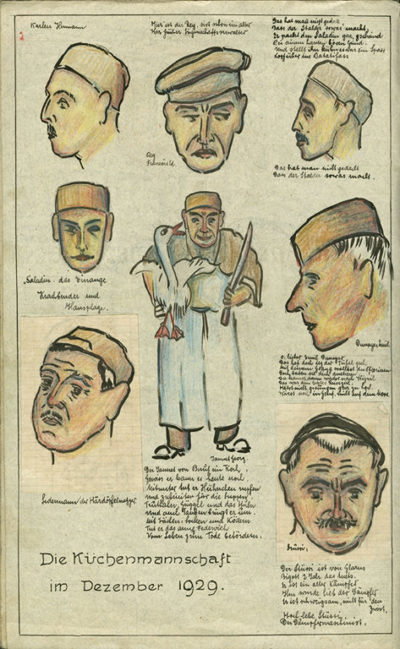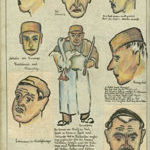Everyday life in a labour facility described in a comic – the «Witzwiler Illustrierte»
 A page of a comic drawn by a detainee of the labour facilities of Witzwil in Gampelen (Bern), year 1, no. 3, December 1929
A page of a comic drawn by a detainee of the labour facilities of Witzwil in Gampelen (Bern), year 1, no. 3, December 1929 The source and its author
The «Witzwiler Illustrierte» is a fascicule of approximately 90 sheets of paper in A3-format, that are kept – partly attached and partly loose – at the State Archives in Bern. The oldest document (year 1, no. 2) dates from November 1929, the most recent (no. 6) from April 1931. There are at least six issues, of which the numbers 2, 3, 4 and 6 are to be found at the Archives. Issue number 3 of December 1929 has been entirely preserved and is kept together with a page of the fourth issue of January 1930 (s. documents here under).
The artist signed himself either E. Neuenschwander or E N, which prompts the conclusion that there was only one author. Probably it was a certain Emil Rudolf Neuenschwander (born in 1892), whose name appears in the entry register of the facilities of Witzwil at that time. He was first detained for a year in April 1928 due to an alleged «dissolute way of life» and a second time in July 1929 for eight months. As the most recent issue dates from April 1931, he must have been detained at least one other time. According to the register, Neuenschwander was a locksmith.
A rare source
The «Witzwiler Illustrierte» is a rare source not only because of its high artistic quality, but also because it reproduces the point of view of a detainee. Neuenschwander combines image and text and captures, using the medium of the comic, everyday life in the labour facilities, his contemporaries and the welfare policy of the Canton Bern. Surpassing what is purely documentary and interpreting his experiences through art, he goes beyond usual subjective narration. Neuenschwander’s «Illustrierte» is an even more valuable witness of the times, because with his pictures the author always stays very near to his own life, portrays his fellow detainees, the facility priest or local politicians and (humorously) captures daily events like a fire that broke out in December 1929.
Analysis of the source
A deep analysis of the «Illustrierte» would for example imply giving the fellow detainees and the office-holders drawn by Neuenschwander a name on the basis of entry and exit registers and of staff lists and substantiating single events with annual reports. As part of the record material, such as the detainees’ dossiers, no longer exist, events like acts of violence and accidents that are portrayed in the comic can hardly be verified in detail.
K. Heiniger/Translation
Source
A page of a comic drawn by a detainee of the labour facilities of Witzwil in Gampelen (Bern), year 1, no. 3, December 1929.
Signature: Staatsarchiv Bern (StABE), BB 4.2.248.
 previous source
previous source
 next source
next source


